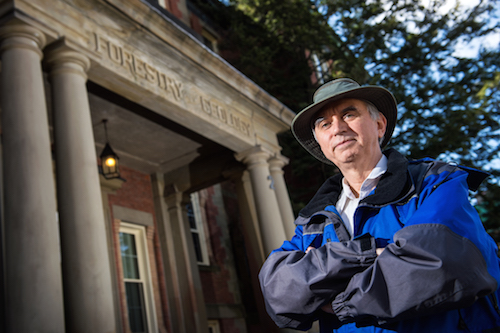UNB researcher helps 15-year-old student discover forgotten Mayan city
Author: Communications
Posted on May 10, 2016
Category: UNB Fredericton , UNB Saint John
A 15-year-old student from Quebec has discovered what could be the site of a lost Mayan city thanks to advice from a University of New Brunswick researcher.
Armand LaRocque, a remote sensing expert at UNB, has helped William Gadoury prove his theory about the relationship between constellations and Mayan cities. Mr. Gadoury believed citizens built their towns under the constellations.
Working together and analyzing satellite images of an area in the Yucatan jungle, they have found what could be a road system and the potential remains of a Mayan pyramid.
“This is a very exciting discovery which could lead to another Mayan settlement being confirmed,” said Dr. LaRocque.
The two met at a conference in July 2014, after Mr. Gadoury’s project won him the chance to attend the International Geoscience and Remote Sensing Symposium in Quebec City.
“I met William and he explained his theory to me,” Dr. LaRocque said. “He asked for my advice because he had encountered a problem – one of the brightest stars of the Mayan constellations was not among previously discovered Mayan sites.
“According to him, the site would be located in the equatorial forest, which is very dense. He had no idea how to prove the existence of this city."
Dr. LaRocque suggested using satellite images and remote sensing to help Mr. Gadoury.
“He was very happy, because it’s very far and expensive to go exploring,” said Dr. LaRocque. “He tried to interpret the images he collected but wasn’t successful because of the density of the forest.”
The area had seen a small wildfire in 2005, so using satellite images from 2006, Dr. LaRocque had more of an opportunity to spot features of the lost Mayan city. Using a near-infrared band he detected what appeared to be a network of lines, similar to a street system. In another image, Dr. LaRocque observed what could have been a wharf in a pond.
“William ordered two satellite images from a former Université de Sherbrooke student of mine, who is now a project leader at the Canadian Space Agency. In those images it was possible to delineate a very large, unnatural rectangle, which I think this feature could be the base of a Mayan pyramid.”
One of these pieces of information on its own wasn’t enough, Dr. LaRocque said, but all of them together strengthen the theory.
Mr. Gadoury, who is now in Grade 11, will present his project at the Canada-Wide Science Fair in Montreal next week.
Dr. LaRocque will continue advising Mr. Gadoury in his research. The two communicate often about their work and Dr. LaRocque believes they will author a research paper together sometime in the future – Mr. Gadoury can speak to how he found the city, while Dr. LaRocque can share his remote sensing expertise.
For now, they will continue their research to confirm if this site was once the spot of a Mayan settlement.
They would like to visit the site one day if funding is available. The site is about 100 kilometres from the closest town, which is perhaps why no one else discovered it.
“It’s right in the centre of the jungle. It’s like an Indiana Jones expedition,” Dr. LaRocque said with a laugh.
This isn’t his first foray into discovery, although it’s perhaps the most extraordinary. Dr. LaRocque spends much of his time mapping various parts of the world with incredible accuracy. He mapped permafrost under vegetation in Northern Ontario with 99 per cent accuracy and has mapped New Brunswick’s wetlands with remote sensing.
Media contact: Kelsey Pye
